A Time of Transformation
We all look forward to the change of leaf color which so defines this time of year in the Adirondacks. It is, after all, an amazing phenomenon and one of the most incredible events to witness in the entire world! Our cool nights and recent cold fronts have already started the process of changing our leaves and the past week has found that transition happening quickly. It seems odd, but the transformation from the greens of chlorophyll to the yellows and reds of xanthophylls and anthocyanins often catches me by surprise, and I suddenly wake up and look around and realize that the leaves are at their peak. Now, with a dose of beautiful weather coming, we should be able to enjoy the kaleidoscope of woodland color for the foreseeable future.
And while just enjoying the colors alone can be great, many folks enjoy identifying the species of trees which are transforming. Many species often turn predominantly one color or another, while other species may turn a few different colors depending on the conditions. As always, identification should first be based upon the structure of the leaves and the structure of the tree or shrub. We also need to use whatever information is available. For instance, Paper Birch is obvious by its bark, although people should be aware of Gray Birch which also occurs in the region. If possible it is therefore helpful to find the colorful leaves still attached to the tree. But that’s not always the case as the leaves fall inexorably to the ground. So here is a sampling of leaves to help hikers, paddlers, sightseers, and leaf peepers to identify some of our more common species of trees and shrubs and their leaves during this beautiful time of year.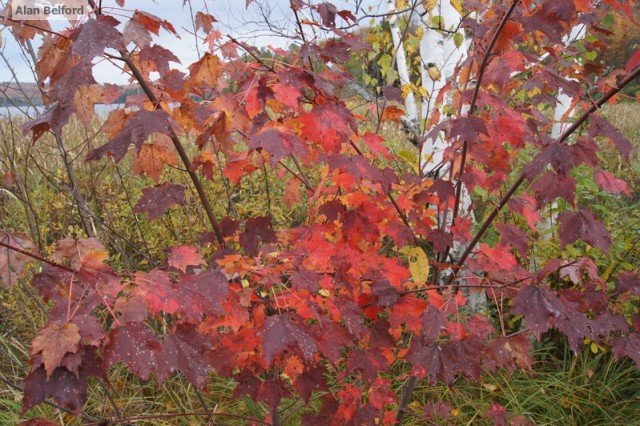
Maples
Some of our most well known deciduous trees in the region are maples, and a few species can be found. Three of the most common species are Red, Sugar, and Striped Maple, and most people know the basic shape of a maple leaf. And, while separating the species is not difficult, many folks have little practice in doing so. Sugar Maple, from which we derive maple syrup, shows 5 major lobes on its leaves which lack teeth, rather showing a smooth outer edge with relatively long points. Sugar Maple turns a few colors in the fall, most notably a bright orange, but also yellow or red.
The colors of Red Maple can be even more variable and individual trees may be deep red or maroon, bright red, orange, or yellow. Red Maple generally shows 3 major lobes on its leaves with two smallish points near the leaf base at times giving it the appearance of 5 lobes. The edges of the leaves are strongly toothed. Striped Maple, by contrast, is generally a small tree or shrub also with 3 lobes. But its large leaves usually only come to 3 major points and the entire margin of the leaf is finely toothed. It turns yellow in the fall.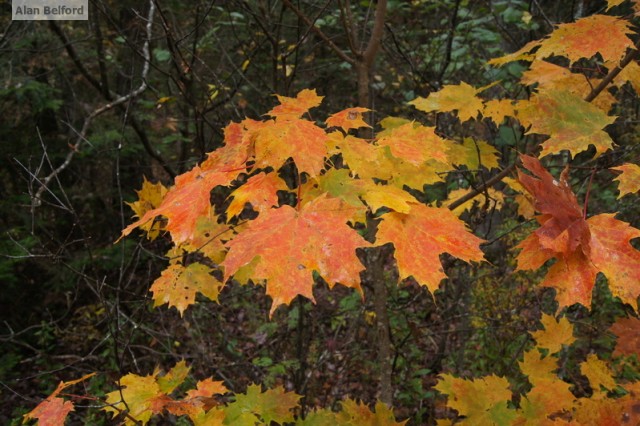
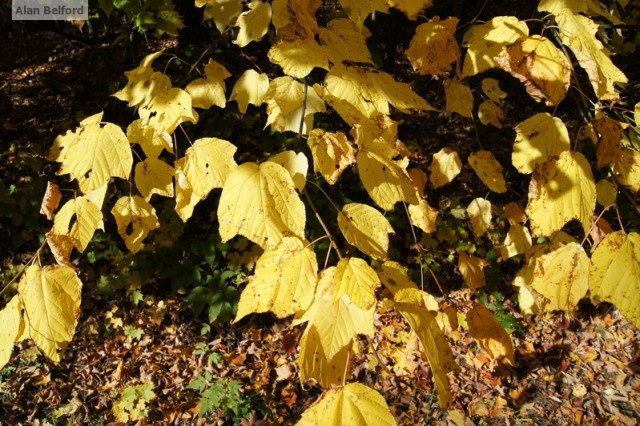
Aspens
The two species of aspen we have here both have a fairly small and rounded or oval leaf. While both turn yellow or gold in the fall, Quaking Aspen leaves have many fine teeth along the leaf margin, while Big-toothed Aspen shows its namesake large, blunt teeth along the leaf edge.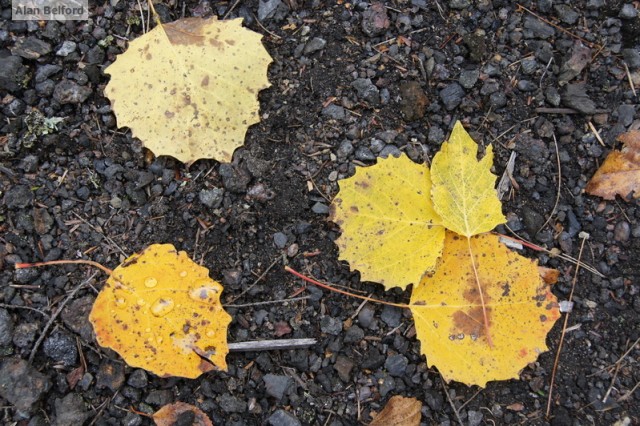
Birches
There are several species in the birch family found in our region, many of which generally turn yellow in the fall. Members of the family have distinctly double-toothed leaves in which the leaves show large and small teeth along their margin. The bark on Paper (White) Birch and the bronzy-yellow bark of Yellow Birch are distinctive and the leaves of Yellow Birch are longer and narrower than those of Paper Birch with generally a more finely toothed edge. Gray Birch by contrast has triangular leaves with long tips and its light colored bark is more grayish white than that of Paper Birch.
Also of note in the birch family are a few common understory species – notably (Eastern) Hophornbeam and Ironwood (sometimes called American Hornbeam). Both show similar birch-shaped leaves which on Hophornbeam usually turn yellow and on Ironwood may be yellow, orange, or reddish. Hophornbeam has dark flaky brown bark, while Ironwood’s bark is gray with ripples in the surface giving the tree a muscular appearance.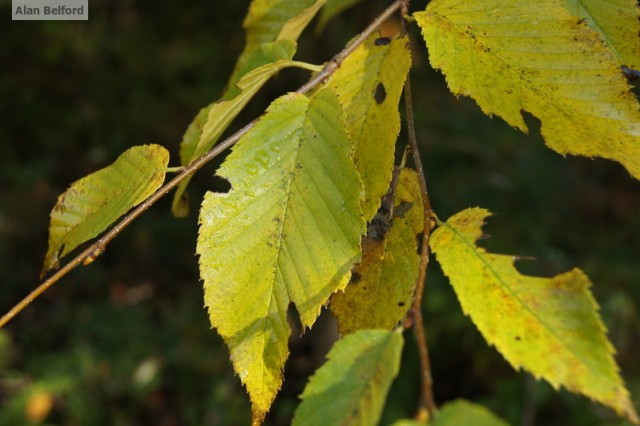
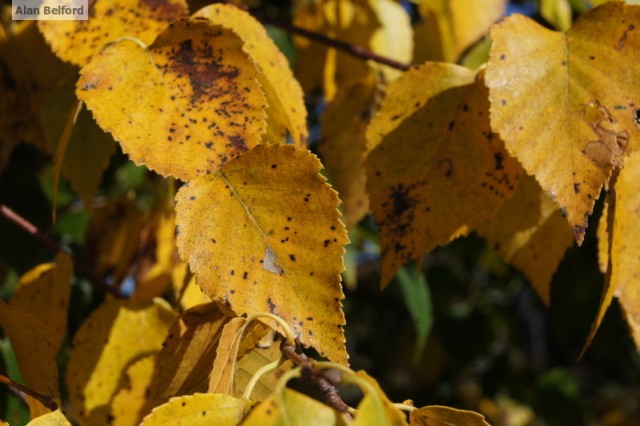
American Beech
American Beech is one of the most common species of trees in our forests and makes up the backdrop to many of our fall scenes. It has gray, smooth bark, and its leaves have many parallel straight veins which run to the long, thin teeth on the leaf margin. The leaves are not double-toothed like members of the birch family, and beech trees turn a golden yellow – some with orange – in the fall. They are also well known for hanging onto their leaves later in the season and some beeches hold pale, straw-colored leaves throughout the winter.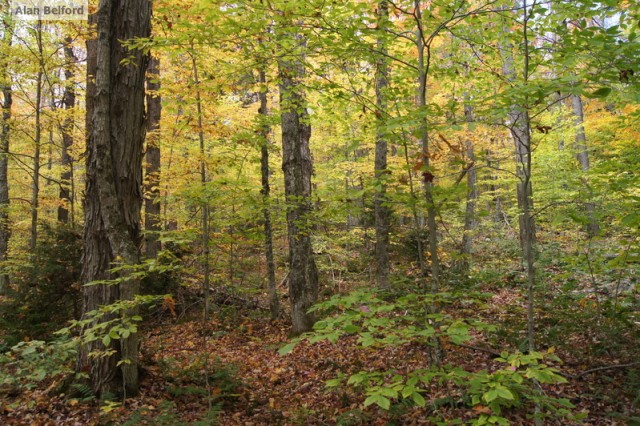
Hobblebush
Included here partly because it is one of my favorite species to watch turn color in the fall is Hobblebush (sometimes called Witch Hobble). Hobblebush’s oval leaves turn a deep purple, accenting the understory and forest floor with their sprawling purple branches. The leaves are also finely toothed with somewhat rounded teeth.
It is an incredible time of year to be outdoors! Hiking, paddling, scenic drives and bike rides are great ways to see all the color fall foliage around Saranac Lake. There's so much to see and enjoy you may want to find a place to stay while you're here.
















